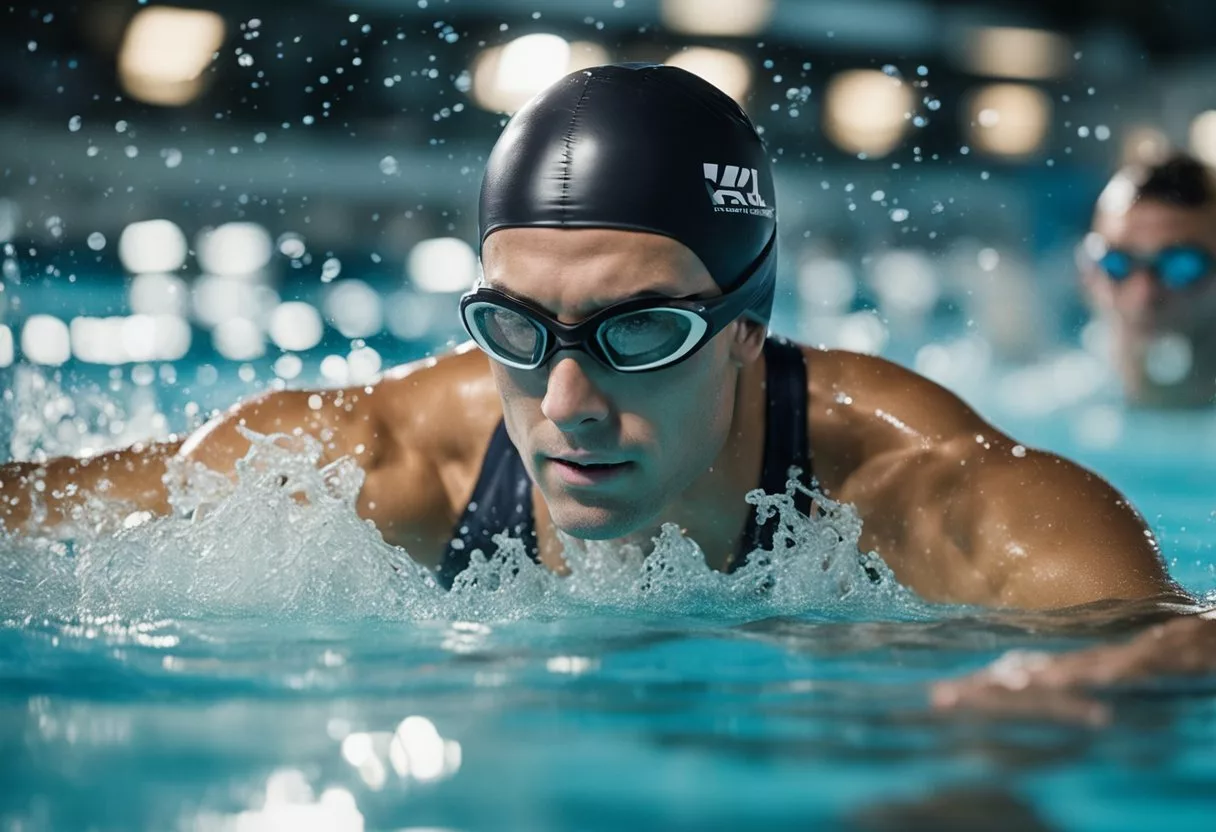Swimming is a popular form of exercise that can provide numerous health benefits. Swimming every day can be an effective way to improve overall health and fitness. But what exactly happens to your body if you swim everyday?
Swimming is a low-impact exercise that can be done by people of all ages and fitness levels. It is a great way to improve cardiovascular health, build endurance, and strengthen muscles. Swimming can also help to reduce stress and improve mental health. Studies have shown that regular swimming can lower the risk of chronic diseases such as heart disease, stroke, and diabetes.
If you swim every day, your body will start to adapt to the exercise, and you will begin to see improvements in your overall health and fitness. Your heart and lungs will become stronger, your muscles will become more toned, and your endurance will improve. Additionally, swimming can help to improve flexibility, balance, and coordination.
Physical Health Improvements

Regular swimming can have significant physical health benefits. Here are some of the ways swimming can improve physical health:
Cardiovascular Health
Swimming is an excellent form of aerobic exercise, which can improve cardiovascular health. Swimming can make the heart and lungs stronger, and may even reduce the risk of death. Swimming engages the entire body, making it a great way to get the heart pumping and improve circulation. Additionally, swimming can help lower blood pressure and reduce the risk of stroke.
Muscle Strength and Tone
Swimming is a resistance exercise that can help build strength and tone muscles. According to Swim Competitive, swimming engages almost every major muscle group, including the glutes, back, abs, shoulders, arms, legs, and torso. Swimming can help build muscle mass, burn calories, and improve overall strength.
Weight Management
Swimming is a great way to burn calories and lose weight. According to Medical News Today, swimming engages almost every major muscle group, requiring a person to use their arms, legs, torso, and stomach. Swimming can burn up to 500 calories per hour, making it an effective way to manage weight.
Enhanced Respiratory Function
Swimming can improve respiratory function and lung capacity. According to Healthline, swimming requires controlled breathing and can help improve breathing techniques. Swimming can also be beneficial for people with asthma, as the warm, humid air in indoor pools can help improve lung function.
Joint and Bone Health
Swimming is a low-impact exercise that can be beneficial for people with arthritis or joint pain. According to Healthline, the buoyancy of water can help reduce stress on the joints and improve range of motion. Additionally, swimming can help improve bone health, particularly in postmenopausal women, by increasing bone mineral density.
Mental and Emotional Benefits

Swimming is not only great for physical fitness, but it also has numerous mental and emotional benefits. Here are some of the ways that swimming can improve your mental and emotional well-being.
Stress Reduction and Mood Enhancement
Swimming has been shown to reduce stress and anxiety levels. According to a study published in the International Journal of Stress Management, swimming can help to reduce symptoms of depression and improve mood. Swimming releases endorphins, which are natural mood-boosters that can help to reduce stress and anxiety.
Improved Sleep Quality
Swimming can also help to improve sleep quality. A study published in the Journal of Sleep Research found that swimming can help to improve both the quality and quantity of sleep. Swimming can help to reduce stress and anxiety, which can lead to better sleep.
Cognitive Function Boost
Swimming can also have a positive impact on cognitive function. A study published in the Journal of Aging Research found that swimming can help to improve cognitive function in older adults. Swimming can also help to improve brain health and reduce the risk of strokes and dementia.
Overall, swimming can have a significant impact on mental and emotional health. It can help to reduce stress, improve mood, enhance sleep quality, and boost cognitive function. Incorporating swimming into your regular fitness routine can help to improve your overall sense of well-being and quality of life.
Lifestyle and Functional Benefits

Increased Overall Fitness
Swimming every day is an excellent way to increase overall fitness levels. It provides a full-body workout that engages all the major muscle groups, including the arms, legs, back, and core. Swimming also improves cardiovascular health and endurance, making it an ideal addition to any exercise routine.
For those who are looking to build strength, swimming can be an effective complement to strength training. It helps to build lean muscle mass and increase metabolism, leading to improved body composition and overall fitness levels.
Support for Special Populations
Swimming is a low-impact exercise that is well-suited for older adults, individuals with disabilities, and pregnant women. It provides a low risk of injury, making it an excellent option for individuals who may be at risk for injury during other types of exercise.
For individuals with multiple sclerosis, swimming can help to improve physical function and reduce fatigue. It can also be an effective form of rehabilitation for those recovering from injury.
Injury Prevention and Rehabilitation
Swimming can help to prevent injury by improving flexibility, range of motion, and overall physical function. It is also an effective form of rehabilitation for individuals recovering from injury, as it provides a low-impact workout that can help to rebuild strength and mobility.
In addition to its injury prevention and rehabilitation benefits, swimming can also help to reduce stress and improve mental health. It provides a low-impact, full-body workout that can help to alleviate anxiety and depression, leading to improved overall well-being.
Overall, swimming every day can provide a wide range of lifestyle and functional benefits. It is an excellent way to improve overall fitness levels, support special populations, and prevent injury.
Swimming Techniques and Practices
Different Swimming Strokes
Swimming is an excellent form of exercise that can improve overall health and fitness. There are several different swimming strokes, including freestyle, backstroke, and breaststroke. Each stroke works different muscle groups and can help improve cardiovascular fitness and endurance. Freestyle is the most common stroke and is often used for aerobic exercise.
Breathing and Form
Proper breathing and form are essential for effective swimming. When swimming, it is important to breathe deeply and regularly to help improve oxygen flow to the body. Breathing techniques can vary depending on the stroke used. Proper form is also important to help reduce the risk of injury and improve swimming efficiency. Swimmers should focus on maintaining good posture, keeping their head down, and using their arms and legs in a coordinated manner.
Training Intensity and Duration
Swimming can be a moderate-intensity or high-intensity aerobic activity depending on the intensity and duration of the swim. For example, swimming at a moderate intensity for 30 minutes can help improve cardiovascular fitness and endurance. Increasing the intensity or duration of the swim can help improve VO2 max, which is a measure of the body’s ability to use oxygen during exercise. It is important to gradually increase the intensity and duration of swimming to avoid injury and improve overall fitness.
In summary, swimming is a great form of physical activity that can provide numerous health benefits. By using different swimming strokes, focusing on proper breathing and form, and gradually increasing the intensity and duration of the swim, swimmers can improve their overall fitness and endurance.
Nutrition and Hydration Considerations

Swimming every day can be physically demanding, which is why proper nutrition and hydration are essential to support the body’s needs.
Calories
Swimming is a high-intensity exercise that can burn a significant amount of calories. According to Precision Nutrition, a 155-pound person can burn up to 372 calories during 30 minutes of moderate swimming. Therefore, it is important to consume enough calories to maintain energy levels and support the body’s needs.
Protein
Protein is an essential nutrient that helps repair and build muscles. Swimming can cause muscle breakdown, making it important to consume enough protein to support muscle recovery. According to Precision Nutrition, swimmers should aim to consume 1.2-2.0 grams of protein per kilogram of body weight per day. Good sources of protein include lean meats, fish, eggs, and plant-based sources such as tofu and legumes.
Hydration
Swimming can cause significant fluid loss through sweating, making it important to stay hydrated. According to SwimSwam, swimmers should aim to drink 16-20 ounces of water 2-3 hours before swimming, 8-10 ounces of water every 10-20 minutes during swimming, and 24 ounces of water for every pound of body weight lost after swimming. It is also important to consume electrolytes such as sodium and potassium to maintain proper fluid balance in the body. Good sources of electrolytes include sports drinks and coconut water.
In summary, proper nutrition and hydration are essential for swimmers who swim every day. Swimmers should aim to consume enough calories to maintain energy levels, enough protein to support muscle recovery, and stay hydrated by drinking enough water and consuming electrolytes.
Environmental and Safety Measures

Chlorine and Other Pool Chemicals
Swimming pools are often treated with chlorine and other chemicals to keep the water clean and free of harmful bacteria. While these chemicals can help prevent waterborne illnesses, they can also have negative effects on the body. Exposure to high levels of chlorine can cause skin and eye irritation, as well as respiratory problems. It is important to follow proper pool maintenance guidelines, such as regularly testing the water and maintaining appropriate chlorine levels, to ensure a safe swimming environment.
Sun Exposure and Protection
Swimming outdoors can expose the body to harmful UV radiation from the sun. Overexposure to the sun can cause skin damage, including sunburns, premature aging, and an increased risk of skin cancer. It is important to protect the skin by wearing sunscreen with a high SPF, wearing protective clothing, and seeking shade during peak sun hours.
Water Quality and Types
The quality of the water in which you swim can have a significant impact on your health. Natural bodies of water such as oceans, lakes, and rivers can contain harmful bacteria, parasites, and other pathogens that can cause illness. It is important to avoid swimming in water that has been contaminated with sewage or other pollutants. Saltwater can also have negative effects on the body, such as drying out the skin and nails.
When swimming in a pool, it is important to pay attention to the type of water being used. Saltwater pools are becoming increasingly popular as an alternative to traditional chlorine pools. While saltwater can be less harsh on the skin and eyes, it is important to note that the water still contains chlorine and other chemicals. It is important to follow proper maintenance guidelines to ensure a safe swimming environment.
Overall, swimming is a great form of exercise that can have numerous health benefits. However, it is important to take proper environmental and safety measures to ensure a safe and enjoyable swimming experience.
Accessibility and Community Aspects

Affordability and Availability
Swimming is a low-impact exercise that can be enjoyed by people of all ages and fitness levels. However, the cost of swimming can be a barrier for some individuals. The good news is that there are many affordable options available for those who want to swim regularly. Many public pools offer discounted rates for seniors, children, and low-income individuals. Additionally, some community centers and YMCA’s offer free or low-cost swim lessons and water aerobics classes.
Another factor that can affect accessibility is the availability of swimming facilities. In some areas, there may be a lack of public pools or community centers with swimming facilities. This can make it difficult for individuals who do not have access to private pools to swim regularly. However, many cities and towns are investing in public pool infrastructure to make swimming more accessible to all members of the community.
Swimming Lessons and Programs
Learning to swim is an important life skill that can improve water safety and increase confidence in the water. Many children and adults, particularly those from low-income families or marginalized communities, may not have the opportunity to learn to swim. Fortunately, there are many organizations that offer affordable or free swim lessons and programs to these individuals.
For example, the USA Swimming Foundation’s Make a Splash initiative provides free or low-cost swim lessons to children in underserved communities. The program has taught over 7.5 million children how to swim since its inception in 2007. Additionally, the YMCA offers swim lessons and water safety programs for children and adults of all ages.
Overall, swimming is an accessible and community-oriented activity that can provide numerous health benefits. By making swimming more affordable and available, and by providing swim lessons and programs to underserved communities, more individuals can enjoy the benefits of swimming and improve their overall health and well-being.
Long-Term Commitment and Lifestyle Integration

Swimming every day can be a great way to improve your quality of life and establish a healthy exercise routine. However, it is important to consider the long-term commitment and lifestyle integration required to maintain this habit.
Making swimming a part of your daily routine can be challenging, but it can also be very rewarding. It is important to set realistic goals and establish a routine that works for your lifestyle. This may involve finding a convenient pool or open water location, scheduling your swim sessions at a consistent time each day, and tracking your progress to stay motivated.
Over time, swimming every day can become a key part of your overall lifestyle. It can help you maintain a healthy weight, reduce stress, and improve your cardiovascular health. Additionally, swimming can be a great way to socialize and connect with others who share your passion for the sport.
However, it is important to remember that swimming every day is not a magic solution to all of life’s problems. It is just one part of a healthy lifestyle that includes a balanced diet, regular exercise, and good sleep habits. It is also important to listen to your body and take breaks when needed to avoid injury or burnout.
In conclusion, swimming every day can be a great way to improve your overall health and well-being, but it requires a long-term commitment and lifestyle integration. By setting realistic goals, establishing a routine, and listening to your body, you can make swimming a key part of your daily routine and enjoy the many benefits it has to offer.